管理学院毕业设计(论文)范例
毕业论文任务书(范本)
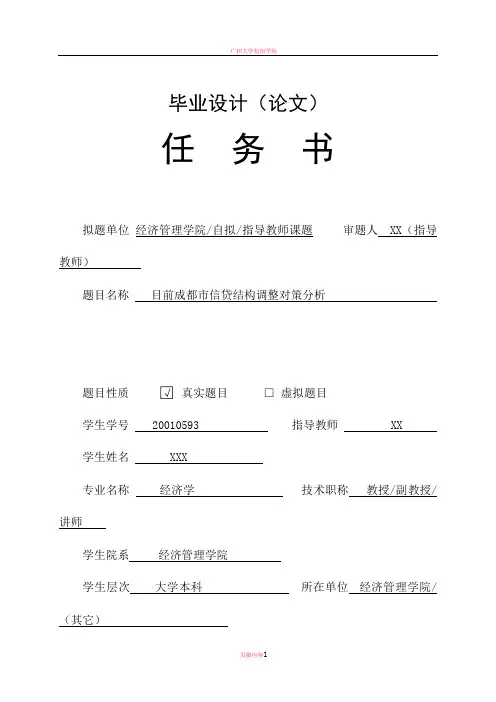
毕业设计(论文)任务书拟题单位经济管理学院/自拟/指导教师课题审题人 XX(指导教师)题目名称目前成都市信贷结构调整对策分析题目性质□√真实题目□虚拟题目学生学号 20010593指导教师 XX学生姓名 XXX专业名称经济学技术职称教授/副教授/讲师学生院系经济管理学院学生层次大学本科所在单位经济管理学院/(其它)2005年 1 月 4 日毕业设计(论文)的内容与要求:一、论文的内容以健全和完善信贷结构调整的外部环境,促进市场调节作用和发挥为目标,研究目前成都市信贷结构调整的对策。
论文首先回顾“九五”以来成都市经济和金融的发展特点和现状,以经济和金融的发展特点和现状作为出发点,分析目前的经济和金融的环境,以此作为信贷环境的衬托。
然后分析现阶段信贷结构调整的特点和难点,其中主要以信贷的集中趋势为主要研究对象,从其分析中直接引导出目前对信贷结构做出调整所面临的有利条件,提出针对性对策。
二、论文的写作要求(一)总体要求1. 选题符合专业培养目标,难易度适当,具有理论意义或实际价值。
2. 论文必须文题相符,概念清楚,思路清晰,层次分明,论据充分、可靠,引用正确,论证有力。
3. 论文符合写作规范。
4. 论文的字数要求在0.9万字以上。
5. 论文必须清楚反映自己的学术观点和学术水平,严禁抄袭。
(二)进度要求2004年12月15日——12月31日,初步查阅资料和调查研究,拟定题目2005年1月1日——1月4日,指导教师下达毕业论文任务书2005年1月5日——1月10日,撰写开题报告2005年2月21日——4月17日,进行毕业实习,同时查阅资料,调查研究,拟定论文写作大纲;2005年4月18日——5月14日,学生完成毕业论文初稿;2005年5月15日——5月25日,修改论文初稿;2005年5月25日——6月2日,毕业论文定稿和装订;2005年6月13日——6月16日,毕业论文答辩;(三)需要阅读的主要参考文献[1]黄亮张永青.2003年度中国企业金融研究报告[R].北京:中国金融研究中心,2003.[2]连育青.在股份制改造中不断提升信贷管理质量[J].现代商业银行,2004,6:.[3]人民银行成都分行金融研究处.2004年上半年西南四省区经济金融运行情况分析[J].西南金融,2004,9.[4]夏斌高尚文陈道富.当前信贷趋势判断与建议[J].西部论丛,2003,10.[5]崔新桓赵西彭小菊程亨丽.2002年四川经济展望.四川省经济信息中心.[6]薛波王芳.2002年四川区域经济发展与趋势分析. 四川省经济信息中心.学院负责人:(签字)年月日。
管理学院信息管理专业毕业设计(论文)
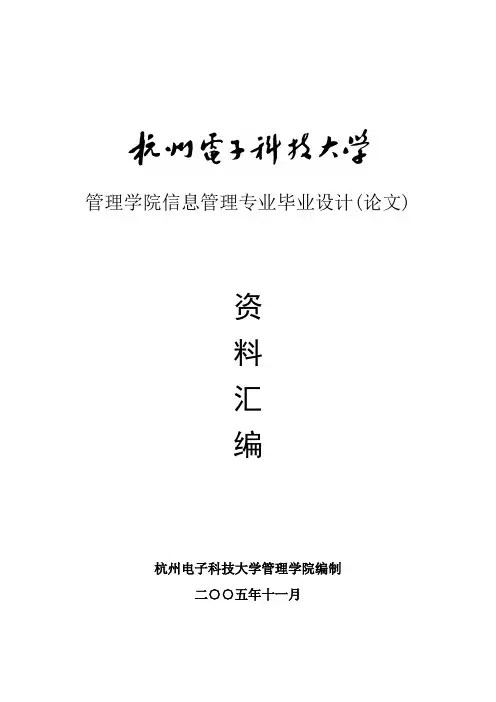
管理学院信息管理专业毕业设计(论文)资料汇编杭州电子科技大学管理学院编制二○○五年十一月目录1、前言2、信管专业本科生毕业设计(论文)指南3、关于2006届信息管理专业毕业论文有关事项的说明4、关于2006届信息管理专业毕业设计(论文)工作的时间安排5、杭州电子科技大学信息管理专业本科英文期刊阅读指南6、附件1:开题报告写作规范7、附件2:毕业设计指导记录表8、附件3:应该如何撰写文献综述9、附件4:文献综述中的问题10、附件5:文献综述范文11、附件6:信息管理专业毕业设计(论文)评分标准前言通过毕业设计与论文阶段的系统实践,使学生巩固和充实所学基础理论和专业知识,培养综合运用所学知识解决企业信息管理中实际问题的初步能力,养成理论联系实际的优良学风,严肃认真的工作态度,掌握信息管理工作所应具备的调查研究、收集资料、查阅文献、外文翻译、文献综述、系统开发、分析论证、写作表达等最基本的技能。
这本编辑的关于信息管理专业毕业论文相关资料集和有关的要求,希望有助于同学们能够认真完成毕业设计和论文阶段的各项任务。
1、2006届信管专业学生毕业阶段的总的进度安排,在第3、4项资料栏目中列出,希望大家严格按照这个进度安排开展各项工作。
2、信息管理专业本科学生英文期刊阅读指南,主要列出杭州电子科技大学图书馆的外文期刊数据库的专业刊物。
希望大家在选择和翻译外文资料时,一定要选择外文专业期刊杂志,不要选择外文书刊翻译,翻译的内容与你所做的毕业论文内容有一定关系,并在你的论文撰写内容和参考文献中,应有所体现。
3、关于文献综述的撰写要求、撰写技巧和方法已在附件3、附件4中列出,并在附件5列出一篇文献综述范例。
希望大家在撰写文献综述时,一定要参考五篇以上的文献,不然就不能称为文献综述。
文献综述涉及的文献内容应在你撰写的论文内容和参考文献中有所体现。
4、关于外文翻译,请大家关注翻译的技巧,主要在关键词、关键段落的专业术语上要翻译准确,在一般的句子上能够正确地表述其含义,语句通顺,符合中国人理解和阅读的习惯。
贵阳学院本科毕业论文写作规范(经管学院)
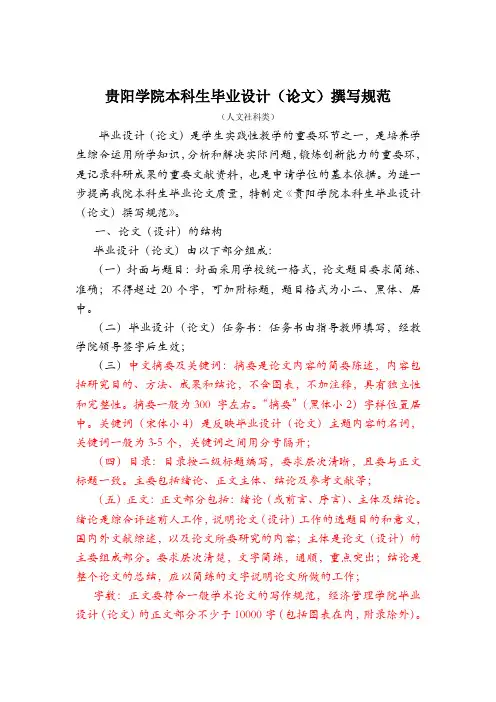
贵阳学院本科生毕业设计(论文)撰写规范(人文社科类)毕业设计(论文)是学生实践性教学的重要环节之一,是培养学生综合运用所学知识,分析和解决实际问题,锻炼创新能力的重要环,是记录科研成果的重要文献资料,也是申请学位的基本依据。
为进一步提高我院本科生毕业论文质量,特制定《贵阳学院本科生毕业设计(论文)撰写规范》。
一、论文(设计)的结构毕业设计(论文)由以下部分组成:(一)封面与题目:封面采用学校统一格式,论文题目要求简练、准确;不得超过20个字,可加附标题,题目格式为小二、黑体、居中。
(二)毕业设计(论文)任务书:任务书由指导教师填写,经教学院领导签字后生效;(三)中文摘要及关键词:摘要是论文内容的简要陈述,内容包括研究目的、方法、成果和结论,不含图表,不加注释,具有独立性和完整性。
摘要一般为300 字左右。
“摘要”(黑体小2)字样位置居中。
关键词(宋体小4)是反映毕业设计(论文)主题内容的名词,关键词一般为3-5个,关键词之间用分号隔开;(四)目录:目录按二级标题编写,要求层次清晰,且要与正文标题一致。
主要包括绪论、正文主体、结论及参考文献等;(五)正文:正文部分包括:绪论(或前言、序言)、主体及结论。
绪论是综合评述前人工作,说明论文(设计)工作的选题目的和意义,国内外文献综述,以及论文所要研究的内容;主体是论文(设计)的主要组成部分。
要求层次清楚,文字简练,通顺,重点突出;结论是整个论文的总结,应以简练的文字说明论文所做的工作;字数:正文要符合一般学术论文的写作规范,经济管理学院毕业设计(论文)的正文部分不少于10000字(包括图表在内,附录除外)。
(六)参考文献:为了反映论文(设计)的科学依据和作者尊重他人研究成果的严肃态度,同时向读者提供有关信息的出处,正文之后应刊出主要参考文献。
参考文献不少于15篇,其中,英文参考文献不少于3篇。
二、具体要求(一)打印要求:毕业设计(论文)要求用A4纸单面打印。
毕业设计任务书范例
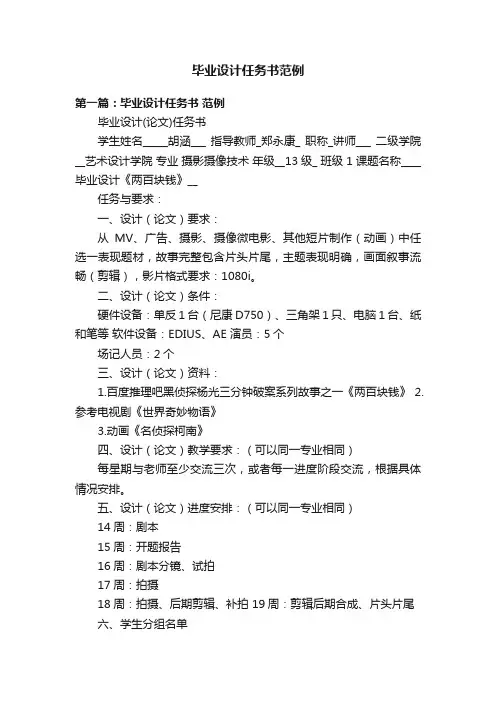
毕业设计任务书范例第一篇:毕业设计任务书范例毕业设计(论文)任务书学生姓名_____胡涵___ 指导教师_郑永康_ 职称_讲师___ 二级学院__艺术设计学院专业摄影摄像技术年级__13级_ 班级 1 课题名称____毕业设计《两百块钱》__任务与要求:一、设计(论文)要求:从MV、广告、摄影、摄像微电影、其他短片制作(动画)中任选一表现题材,故事完整包含片头片尾,主题表现明确,画面叙事流畅(剪辑),影片格式要求:1080i。
二、设计(论文)条件:硬件设备:单反1台(尼康D750)、三角架1只、电脑1台、纸和笔等软件设备:EDIUS、AE 演员:5个场记人员:2个三、设计(论文)资料:1.百度推理吧黑侦探杨光三分钟破案系列故事之一《两百块钱》2.参考电视剧《世界奇妙物语》3.动画《名侦探柯南》四、设计(论文)教学要求:(可以同一专业相同)每星期与老师至少交流三次,或者每一进度阶段交流,根据具体情况安排。
五、设计(论文)进度安排:(可以同一专业相同)14周:剧本15周:开题报告16周:剧本分镜、试拍17周:拍摄18周:拍摄、后期剪辑、补拍 19周:剪辑后期合成、片头片尾六、学生分组名单导演:胡涵编剧:胡涵摄影:胡涵周栩江演员:胡涵周栩江等后期;胡涵注:本任务书一式2份,学生、二级学院各一份第二篇:毕业设计任务书武汉大学本科毕业设计任务书毕业设计题目:兴山外小校园标识、室内展示及校园文化广场设计学院:城市设计学院学号姓名一、毕业设计题目的来源该设计受兴山县外国语小学负责人委托,进行该校的相关设计。
二、毕业设计应完成的主要内容本次毕业设计结合该项目真题真做,具体设计任务及要求如下:湖北省兴山县外国语小学拟对其校园标识、教学楼内展示以及景观规划作统一的设计,根据委托人意见,重点是对该小学教学楼走廊及楼道的展示设计以及校园景观的设计与规划。
该小学具体布局见图1。
其设计内容具体如下:1、校园标识设计该部分设计重点是校园的标识设计以及在景观和展示设计中的应用。
毕业设计浙江工商大学工商管理学院...

毕业设计Ⅲ.外文翻译外文翻译之一Why companies should have open business models作者:Henry Chesbrough国籍:American出处:Sloan Management Review, Winter 2007, 48 (2): 22-28原文正文:Innovation is becoming an increasingly open process thanks to a growing division of labor. One company develops a novel idea but does not bring it to market. Instead, the company decides to partner with or sell the idea to another party, which then commercializes it. To get the most out of this new system of innovation, companies must open their business models by actively searching for and exploiting outside ideas and by allowing unused internal technologies to flow to the outside, where other firms can unlock their latent economic potential. Let‘s be clear about what is meant by the term business model. In essence, a business model performs two important functions: It creates value, and it captures a portion of that value. The first function requires the defining of a series of activities (from raw materials through to the final customer) that will yield a new product or service, with value being added throughout the various activities. The second function requires the establishing of a unique resource, asset or position within that series of activities in which the firm enjoys a competitive advantage.Open business models enable an organization to be more effective in creating as well as capturing value. They help create value by leveraging many more ideas because of their inclusion of a variety of external concepts. They also all ow greater value capture by utilizing a firm‘s key asset, resource or position not only in that organization‘s own operations but also in other companies‘ businesses.To appreciate the potential of this new approach, consider the following names: Qualcomm Inc., the maker of cellular phone technology; Genzyme Corp., abiotechnology company; The Procter & Gamble Co., a consumer products corporation; and Chicago, the musical stage show and movie. This assortment might appear to be random, but they all have something in common: Each required an open business model in which an idea traveled from invention to commercialization through at least two different companies, with the different parties involved dividing the work of innovation. Through the process, ideas and technologies were bought, sold, licensed or otherwise transferred, changing hands at least once in their journey to market.Qualcomm used to make its own cell phones and base stations but ceased doing so years ago.1 Now others manufacture those products, and Qualcomm just makes chips and sells licenses to its technologies, period. In fact, every phone that uses its technology is sold by a customer of Qualcomm, not by the company itself.Genzyme licenses technology from the outside and then develops it in-house. The company has turned these external ideas into an array of novel therapies that deliver important cures for previously untreatable rare diseases. It has also built an impressive financial record in an industry in which profits have been difficult to achieve.2Procter & Gamble has rejuvenated its growth through a program called Connect and Develop, which licenses or acquires products from other companies and brings them to market as P&G brands. With early successes like the Crest SpinBrush, Olay Regenerist and Swiffer Dusters, P&G now actively seeks external ideas and technologies through an extensive network of scouts. Chicago, the often-revived musical, emerged out of a creative extension of a play written decades ago that had gone out of print.3 Others saw the latent value within the work and revived it multiple times to yield a prize-winning show. And each time the show was revived, it was done by a different owner. A recent revival turned into an Academy Award –winning movie in 2002.If t hese ideas were so valuable, then the obvious question is: Why didn‘t theoriginal owners figure out the best way to take them to market on their own? The answer goes to the very heart of why markets for innovation are so important. Different companies possess different assets, resources and market positions, and each has a unique history.4 Because of that, companies look at opportunities differently. They will quickly recognize ideas that fit the pattern that has proven successful for them in the past, but they will struggle with concepts that require an unfamiliar configuration of assets, resources and positions. With innovation markets, ideas can flow out of places where they do not fit and find homes in companies where they do.Innovation InefficienciesIn many industries, markets for innovation have existed for a long time. In the chemical industry, for instance, compounds have often moved from one company to another.5 Historically, though, such markets have been highly inefficient. Even now, much of the exchange of technology and its associated intellectual property occurs through a cottage industry of brokers and patent attorneys. Although transactions do occur, the price and other terms of the transactions are difficult to discern. This makes it difficult to determine the overall size of activity and to know what the fair price is for a particular technology. And, of course, in highly inefficient markets a good deal of potentially valuable trade in innovation does not occur. The costs are so high and t he potential value so difficult to perceive that innovation often sits ―on the shelf,‖ unused. One way to quantify this waste is to look at a company‘s patent utilization rate —the number of patents that the firm uses in its business divided by the total number of patents that it owns. In an informal survey, I have found that companies utilize less than half of their patented technologies in at least one of their businesses. The range I‘ve heard is between 5% and 25%. Thus, in my admittedly unscientific sampling, somewhere between 75% and 95% of patented technologies are simply dormant.Rising Costs, Shorter TimesAn important factor spurring the process of open innovation is the rising cost of technology development in many industries. Case in point: the soaring cost of building a semiconductor fabrication facility, or ―fab.‖ In 2006, Intel Corp.announced two new fabs, one in Arizona and the other in Israel. Each was estimated to cost more than $3 billion. Just 20 years ago, a new fab would have cost about 1% of that. Another example is pharmaceutical drug development. Investment in a successful product has risen to well over $800 million, up more than ten-fold from just a decade earlier. Even the consumer products industry is feeling the pressure. P&G estimates that its Always brand of feminine hygiene pads, which cost $10 million to develop a decade ago, would set the company back anywhere from $20 million to $50 million today, according to Jeff Weedman, who is responsible for external business development at P&G.The rising costs of technology development would imply that only the big will get bigger, with everyone else falling behind. But there‘s a second force at play: the shortening life cycles of new products. In the computer industry during the early 1980s, for example, hard disk drives would typically ship for four to six years, after which a new and better product became available. By the late 1980s, the expected shipping life had fallen to two to three years. By the 1990s, it was just six to nine months.In pharmaceuticals, the expected shipping life of new drugs while they enjoy patent protection has shortened because of longer testing procedures and quicker entry by manufacturers of generics. And in the largest market segments, successful drugs must often contend with a number of rival products. For example, at least five statin prescription drugs are currently being sold, all of them aimed at addressing elevated cholesterol levels andheart disease.As a result of both trends — rising development costs and shorter product life cycles — companies are finding it increasingly difficult to justify investments in innovation. (See ―The Economic Pressures on Innovation.‖) Open business models address both effects. It attacks the cost side of the problem by leveraging external research-and-development resources to save time and money in the innovation process. Consider P&G‘s 6 Pringles Print initiative, through which the company now offers Pringles with pictures and words printed on each chip. To bring that product to market, P&G found and adapted an ink jet technology that a bakery in Bologna, Italy, used to print messages on cakes and cookies. P&G developed Pringles Print at a fraction of the cost and brought it to market in half the time than it would have taken had the company done all the work internally.Open business models also attack the revenue side. P&G, for instance, is creating new brands by licensing technologies from other companies around the world, resulting in products like the SpinBrush, a battery-operated toothbrush, which generated firstyear sales of $200 million. And P&G is also getting money from licensing its technologies to other firms.The combination of leveraged cost and time savings with new revenue opportunities confers powerful advantages for companies willing to open their business models. (See ―The New Business Model of Open Innovation,‖ p. 27.) The development costs of innovation are reduced by the greater use of external technology in a firm‘s own R&D process. This sa ves time as well as money. And the firm no longer restricts itself to the markets it serves directly. Now it participates in other segments through licensing fees, joint ventures and spinoffs, among other means. These different streams of income create more overall revenue from the innovation. The result is that innovation becomes economically attractive again, even in a world of shorter product life cycles.Open ExperimentsWhat can companies do to partake more fully in the benefits of openinnovation? The short answer is that they need to develop the ability to experiment with their business models. Developing that capability requires the creation of processes for conducting experiments and for assessing their results. Although that might seem obvious, many companies simply do not have such processes in place. In most organizations, no single person short of the chief executive officer bears responsibility for the business model. Instead, business unit managers (who are usually posted to their jobs for just two to three years) tend to take the business model for granted. For them, running risky experiments in which the payoffs may not emerge for three or more years is not a high priority.Companies also face certain constraints. Many firms, for example, are understandably hesitant to launch experiments that might risk the reputation of an established brand. The same is true for companies with respect to their distribution channels, manufacturing strategies and so on. But some companies have developed tactics to work around such limitations. Consider, for instance, a food manufacturer that is exploring ways to provide healthier but shelf-stable foods and snacks in high school vending machines. To experiment with different products without risking any damage to its consumer brand, the manufacturer has created a ―white box‖ brand that is not advertised, is not supported and has no obvious connection to the company. Similarly, Google Inc., the online search company, has established a separate Web site () that allows the firm to get consumer feedback on new approaches to user interfaces. Other ways of exploring are through spinning off companies or investing in startups. By observing how well a small organization does with a particular business model, a company can obtain much useful information about the viability of that model.Managerial ImplicationsEach of the three companies began the journey toward a more open business model with a shock or challenge to the status quo. For IBM, the shock was so severe that the company was nearly broken up. In the case of P&G, its stock had fallen in half and a new CEO had been brought in. Air Products did not face the brutal financial adjustments that IBM and P&G did, but a potentialmerger triggered a deep self-examination of how the company did business.Generally speaking, making fundamental changes to a company‘s business model requires clear commitment and support from the top. P&G is the prime example here, as CEO Lafley strongly and explicitly endorsed the Connect and Develop approach to innovation. Lacking that kind of support, the Air Products approach of starting small provides a subtler way to effect change. Either way, the important thing is to build and maintain momentum by continually supplying evidence that supports the transformation and shows that the company is heading in the right direction. This requires repeated experimentation in which the firm pursues new sources of revenue and business value and collects critical information from the market about the potential value of those ideas and technologies. The results then bolster the shift toward the new approach. At P&G, for example, the early successes of the SpinBrush and Swiffer products provided ample proof within the company that Connect and Develop could generate strong bottom-line results.Of course, experimentation only yields value when a company is able (and willing) to act on the information that the experiments generate. Larry Huston‘s early success at P&G with insourcing external products showed that there was money to be made, but it was Gil Cloyd and A.G. Lafley who realized that this new logic could transform P&G‘s business model and boost its overall growth rate.12 Air Products‘ experience to date is helping the company to reth ink how it might finance the high fixed capital investments needed in the industrial chemicals business. As Gus Orphanides, director of licensing at Air Products, explains, ―We used to be a huge [capital expenditure] company, perhaps spending $1 billion a year for a $6 billion company. We started to ask ourselves, ‗Are we getting enough of a return on our shareholders‘ capital?‘ ‖ Today, Air Products is actively seeking creative ways to share those costs with other firms.Making the TransitionWhen building a new business model, companies must figure out what to do with their existing model. Praising a new business model can inadvertently suggest that the current one is somehow obsolete. But the traditional business model can continue to play an important role. P&G, for instance, still develops its own brands and invests substantially in its internal technologies.Managing the coexistence of a new business model alongside an existing one can be tricky. Indeed, when Durk Jager of P&G tried to push too many change initiatives at once, P&G did begin to transform itself but lost the operational discipline to deliver the quarterly earnings numbers that investors expected. Nevertheless, as successful experiments begin to point the way toward a new and more effective business model, the company must undergo a final phase in its transformation. In this stage, the firm will scale up the model, bringing it into high volume across the organization and its customers. The process entails at least two essential elements.First, the business model must be adjusted or rebuilt to handle significant volume. Many business models that work well when only a small number of highly trained people are involved can easily break down when new layers of administration are needed to manage a much larger number of more general workers. If certain processes cannot be automated or standardized, the model may not be able to handle large increases in activity without resulting in a severe degradation of quality. IBM faces this concern in its global consultingbusiness. The skills of its services personnel differ from those of its product and technology people, and IBM now needs many more of the former (specifically, people who can translate customer IT requirements into specific solutions from IBM) and fewer of the latter (device physicists and polymer chemists).Second, the business model must obtain ―buy in‖from important constituencies before being rolled out across the company. Scaling up a business model requires much more funding and far greater organizational commitment than a small experiment does, and those resources must come from somewhere. This often creates ―losers‖ in the organization — groups whose budgets are cut to free up resources to support the new business model. Because of that, the scaling-up process can encounter tremendous internal resistance. That‘s why John Tao‘s approach of starting small at Air Products made so much sense. The initial program required few resources and minimal management attention, thus it triggered little conflict with other parts of the organization. Of course, as the program continued to expand, it led to greater competition for resources. Now, though, Tao‘s efforts have an established history of bringing in new revenues, which have been shared with the associated business units. This additional income has minimized any internal resistance because there‘s now a bigger pie to share, and Tao‘s proven track record has given him more clout in the discussions over how to divide that pie.公司为何必须开放商业模式作者:亨利·切萨布鲁夫国籍:美国出处:斯隆管理评论,2007冬第2期第48卷: 22-28中文译文:随着劳动分工日益明确,创新正逐渐开放化。
Ppthqr经济与管理学院本科生毕业设计论文撰写细则
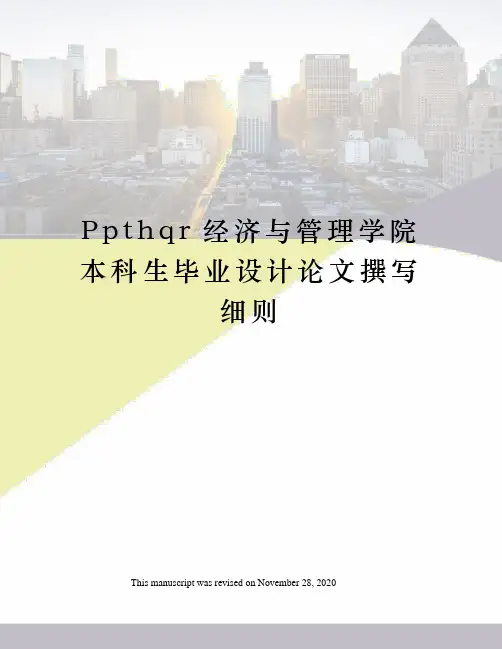
P p t h q r经济与管理学院本科生毕业设计论文撰写细则This manuscript was revised on November 28, 2020生命是永恒不断的创造,因为在它内部蕴含着过剩的精力,它不断流溢,越出时间和空间的界限,它不停地追求,以形形色色的自我表现的形式表现出来。
--泰戈尔经济与管理学院本科生毕业设计(论文)撰写细则2009年9月为了使本科生毕业设计(论文)的撰写更为规范,根据学校有关规章制度(《上海电力学院本科生毕业设计(论文)撰写规范》)并结合我院各专业的特点,特制定本细则。
一、毕业设计说明书(论文)撰写的内容与要求1.标题标题应该简短、明确、有概括性。
标题字数要适当,不宜超过20个字,如果有些细节必须放进标题,可以分成主标题和副标题。
2.摘要与关键词论文摘要以浓缩的形式概括课题的研究内容,中文摘要不少于250字,外文摘要应与中文摘要相对应,关键词一般以3~5个为宜。
3.目录目录按三级标题编写(即:1……、……、1.1.1……),要求标题层次清晰。
目录中的标题应与正文中的标题一致,附录也应依次列入目录。
4.正文毕业设计说明书(论文)正文包括绪论、主体与结论,按篇幅计毕业设计说明书不少于10000汉字,毕业论文不少于20000汉字,其内容分别如下:绪论应说明课题提出的背景、意义、目的、研究范围及要达到的技术要求;简述本课题在国内外的发展概况及存在的问题;说明本课题的指导思想;阐述本课题应解决的主要问题。
主体是对研究工作的详细表述,其内容包括:研究工作的基本前提、假设和条件;模型的建立,实验方案的拟定;基本概念和理论基础;设计计算的主要方法和内容;实验方法、内容及其分析;理论论证,理论在课题中的应用,课题得出的结果,以及对结果的讨论等。
结论是对整个研究工作进行归纳和综合而得出的总结,对所得结果与已有结果的比较和课题尚存在的问题,以及进一步开展研究的见解与建议。
5.致谢致谢应以简短的文字对在课题研究和设计说明书(论文)撰写过程中曾直接给予帮助的人员(例如指导教师、答疑教师及其他人员)表示自己的谢意,这不仅是一种礼貌,也是对他人劳动的尊重,是治学者应有的思想作风。
广州大学工商管理学院本科毕业论文排版规范
(5)网络文献
[1]王明亮.关于中国学术期刊标准化数据库系统工程的进展[EB/OL]. /pub/wml.txt/980810-2.html,1998-08-16/1998-10-04.
(3)对于超过一行的目录内容提前换行,换行后缩进至相应标题第一个字符处。
(4)目录单独编排页码,罗马数字,字体Times New Roman小五,位置居中。
6、论文正文
论文正文包括绪论(前言)、论文主体及结论等部分。论文正文分章节撰写,每章应另起一页。
正文的章节层次以少为宜,应根据实际需要选择。层次代号格式如表1所示:
(2)期刊论文
[1]覃睿,田先钰. 从创新潜力到创新成果:一个创新潜力形成与释放模型[J]. 科技进步与对策,2007(2).
(3)学术会议
[1] 张佐光,张晓宏,仲伟虹,等. 多相混杂纤维复合材料拉伸行为分析[C]//第九届全国复合材料学术会议论文集(下册). 北京:世界图书出版公司,1996.
(4)毕业论文
表1 层次代号及说明
层次名称
示 例
说 明
行 距
章
第1章 □□……□(黑体小二)
章序及章名居中排,章序用阿拉伯数字,与章名空1个半角字符
行距1.2倍,段前1行,段后0.8行
节
1.1 □□……□(黑体小三)
题序顶格书写,与标题间空1个半角字符,阐述内容另起一段
行距1.2倍,段前0.5行,段后0.5行
条
1.1.1 □□……□(黑体四号)
表2 参考文献标识代码
参考文献类型
专著
论文集
报纸文章
校级优秀毕业设计论文-南京理工大学理学院【范本模板】
教育实验学院
96
多通道电能计量与充电过程实时监控系统设计
董文杰
张合
机械工程及自动化(实院)
教育实验学院
97
面向监控视频的行人跟踪算法设计与实现
邵晴薇
赵春霞
计算机科学与技术(实院)
教育实验学院
98
小型化定量相位显微成像仪
张佳琳
陈钱
光电信息工程(实院)
教育实验学院
99
宽带滤波电路中可重构限带结构的设计与分析
陈锦成
韩玉阁
热能与动力工程
能源与动力工程学院
54
重庆市某县人民医院主体(A区)空调系统设计
苏杭
曹琳
建筑环境与设备工程
能源与动力工程学院
55
基于多体系统传递矩阵法的直升机武器系统动力学建模与仿真
王勋
芮筱亭
武器系统与发射工程
能源与动力工程学院
56
氧化铒选择性辐射器光谱辐射特性研究
赵斌
谭洪
热能与动力工程
能源与动力工程学院
73
基于纹理提取与优化的图像矢量化方法
杨阳
李建良
数学与应用数学
理学院
74
分子动力学模拟研究石墨烯材料缺陷演化机理
夏骏
尹晓春
工程力学
理学院
75
声波在颗粒链中的非线性传播特性
矫滕菲
黄德财
应用物理学
理学院
76
ZrTe5,HfTe5的单晶生长及输运性质研究
康宝蕾
吴海平
应用物理学
理学院
77
多个专家数据的集成方法研究
经济管理学院
50
商品评论信息的观点抽取及其分类研究
毕业论文(设计)的写作要求(五篇范例)
毕业论文(设计)的写作要求(五篇范例)第一篇:毕业论文(设计)的写作要求毕业论文(设计)的写作要求梁珠民为了规范我系的学生毕业论文,在此对毕业论文的写作及毕业论文的书写格式作如下具体的要求。
一、毕业论文应遵循的原则1、真实性原则毕业论文内容应是自己在实习过程中亲自做的,如:养猪与猪病防治、养禽与禽病防治、养牛与牛病防治、饲料兽药生产与营销。
2、符合性原则毕业论文的文本结构应符合《学院毕业论文基本规范要求》的格式,共由9个主要部分组成:(1)封面;(2)毕业论文任务书;(3)本人声明;(4)论文目录;(5)论文摘要(不少于500字);(6)毕业论文正文(不少于4000字);(7)参考文献;(8)致谢;(9)附录。
3、专题性原则毕业论文应一事一论、一题一论,专门写某一方面的问题。
4、规范性原则毕业论文内容格式应规范,符合科技论文基本格式要求,其逻辑关系是:提出问题(观点,即选题)→解决问题的方法(如试验材料与方法)→解决问题的结果,并对结果进行分析(结果与分析)→结论(结论与讨论、小结与讨论)。
5、创新性原则毕业论文选题能够体现生产和研究的要求,在理论上或实践上有一定的研究价值,有新意或选择了新的研究视角。
6、科学性原则毕业论文应观点明确,条理清晰,数据准确,采用国际单位,论证严密合理,逻辑推理正确,总结出具有一定规律性的经验,有独到见解。
7、应用性原则毕业论文对解决实际的问题有很强的针对性,可通过实践检验和便于推广。
二、毕业论文基本规范要求1、封面封面采用学院编制的统一格式,封面上填写论文题目、专业、班级、作者姓名、指导教师姓名等内容(见附件一毕业论文封面)。
2、毕业论文任务书毕业论文任务书按学院的统一样式(见附表二毕业论文任务书)填写。
论文题目在老师指导下确定,一般不超过20个字,若语意未尽,可用副标题补充说明。
副标题应处于从属地位,在题目的下一行用破折号“——”引出。
日期由指导老师填写。
3、本人声明(三号黑体居中,字间隔一字距,单独一页)声明内容如下(宋体小四号,空一行起): 我声明, 本论文及其设计工作是由本人在指导教师的指导下独立完成的, 在完成论文时所利用的一切资料均已在参考文献中列出。
华南理工大学本科毕业设计(论文)撰写规范-华南理工大学工商管理学院
华南理工大学本科毕业设计(论文)撰写规范(经管、人文、法学、外语、体育类专业)为了更好地进行本科毕业设计(论文)工作,特制定“本科毕业设计(论文)撰写规范”。
请毕业设计(论文)指导教师和学生认真阅读并按要求撰写(填写)。
一、毕业设计(论文)类型及基本要求1.理论研究类:学生必须独立完成一项研究课题,选题应关注学术前沿和研究热点,论点鲜明、论据充分,论证应有逻辑性,要有一定深度和创新。
文字表达流畅,结构合理。
撰写一篇15000字数以上的研究报告或论文。
2.实验研究类:学生必须独立完成一项研究性的实验,取得足够的实验数据,实验要有探索性,而不是简单重复已有的工作。
撰写一篇15000字数以上的研究报告或论文。
二、毕业设计(论文)资料基本组成需装入档案袋并提交给学院保存的毕业设计(论文)材料包括:1. 任务书;2. 毕业设计(论文)(包括封面、摘要与关键词(中文/英文)、目录、论文(说明书)正文、参考文献、附录(必要时)、致谢(必要时));3. 对应的毕业作品(必要时);4.电子文档;5. 开题报告(文献综述);6. 外文翻译表及外文原件;7. 中期考核表;8. 论文评阅书;9. 总评分及评语表。
三、各资料的具体要求(一)任务书任务书是经教研组(系、研究所)负责人审核,由指导教师向学生下达进行毕业设计的正式教学文件,学生必须根据任务书规定的质和量要求按时完成。
任务书内容应具体、明确,以利于学生掌握和教师检测。
任务书应在毕业设计正式启动前下达,以保证学生有充分时间撰写开题报告。
(二)毕业设计(论文)1.论文题目论文题目应突出重点、简明扼要,能恰当概括论文主要内容,要有较强的科学性和前瞻性、可行性,必要时可增加副标题。
2.摘要摘要是简明、确切地记述毕业设计(论文)工作重要内容的短文。
其基本要素包括研究的目的、方法、结果(结论)和论文的意义等。
应避免将摘要写成目录式的内容介绍。
论文摘要要求400-600字。
摘要页不需写出论文题目。
- 1、下载文档前请自行甄别文档内容的完整性,平台不提供额外的编辑、内容补充、找答案等附加服务。
- 2、"仅部分预览"的文档,不可在线预览部分如存在完整性等问题,可反馈申请退款(可完整预览的文档不适用该条件!)。
- 3、如文档侵犯您的权益,请联系客服反馈,我们会尽快为您处理(人工客服工作时间:9:00-18:30)。
XX工业大学
毕业设计(论文)
题目:外商对华直接投资经济效应分析
副标题:
专业:工商管理指导教师:李晓红
学生XX:李萌班级-学号:工商032-1
2008年6 月
XX工业大学本科毕业设计(论文)
题目:外商对华直接投资经济效应分析
副标题:
学生XX:李萌
专业:工商管理
班级学号:工商032-1
指导教师:
评阅人:
年月日
摘要
中国已成为亚洲最大的外商直接投资国,并且是世界上仅次于美国的第二大引资国。
外商直接投资对我国经济发展起了不可否认的促进作用,但同时,它又是一把“双刃剑”,对我国的经济有一定的负面影响。
因此,正确认识外商对华直接投资的实际效应,对于我国在新时期如何对待FDI具有重要的现实意义。
本文通过对外商对华直接投资问题的规X分析和实证分析,利用SOLOW-SWAN模型和COBB-DOUGLA S模型,对FDI和GDP、FDI和就业、FDI和技术外溢、FDI和进出口贸易进行了分析,以实际数据说明外商对华直接投资对加速我国国内资本的形成、增加就业和提高职工的素质以及扩大出口方面的重大作用。
最后结合我国的实际情况,提出了应在稳定投资政策、创造良好的投资环境、推动落后地区开放程度及取消对外资企业的超国民待遇等方面来制定对待FDI的对策。
关键词:外商对华直接投资;经济效应;经济增长;实证分析
ABSTRACT
…………Foreign Direct Investment has not only promoted the development of economy greatly but also a “double-edged sword”, which h as certain negative influence on the economy. Therefore, knowing the advantages and disadvantages of FDI will have important realistic meaning for our country how to treat FDI in new period.
…………
Keywords:Foreign direct investment;Economic effect;Economy growth;
Demonstrational analysis
目录引言1
第一章FDI理论回顾2
1.1FDI理论的产生阶段2
第二章外商对华直接投资发展情况3
2.1入世前我国利用FDI的概况与特点3 第三章 FDI对我国的经济效应分析4
3.1经济增长效应分析4
第四章 &&&&6
结论7
参考文献8
致谢9
引言
中国自改革开放以来,经济迅速增长,外资的作用不可忽视,尤其是外国直接投资(Foreign Direct Investment, FDI),其对我国经济增长的贡献程度日益增强[1]。
从未来发展趋势来看,直接投资对东道国经济增长的贡献还会进一步提高。
我国入世后,对外开放步伐加快,在FDI 方面表现出外资进入中国的可选择模式增加,投资领域拓宽。
外国直接投资正急速涌入中国,越来越多的跨国公司将中国纳入其全球化发展战略体系之中,成为其全球性生产、采购和销售链条中的重要环节,并将中国作为全球加工制造业生产基地和目标消费市场[2]。
因此做出FDI对中国的经济效应分析是我国制定未来的外资政策和产业政策不可或缺的工作。
基于此,本文拟对……展开研究
第一章FDI理论回顾
1.1 FDI理论的产生阶段
1.1.1 垄断优势理论
二战后的初期由于对国际直接投资研究还处于萌芽时期,经济学家便将国际贸易理论直接运用于对国际直接投资的分析[1],其中具有代表意义的是利润差异论,利润差异论认为国际直接投资所涉及的资本在国际间的流动从实质上讲反映了各国间收益的差异。
1960年美国麻省理工学院的学者海默在其博士论文《国内企业的国际化经营:对外直接投资的研究》中首先对传统理论提出了挑战,并经金德尔伯格等学者补充、发展成为完整的理论。
这个理论被称为垄断优势理论。
垄断优势理论把跨国公司从事对外直接投资所凭借的垄断优势分为:来自产品市场不完全的垄断优势,来自要素市场不完全的垄断优势、来自规模经济的垄断优势、来自政府干预的垄断优势由于海默和金德尔伯格对该理论的巨大贡献,垄断优势理论有时又被称为“海默——金德尔伯格传统”[2]。
1.1.2 产品生命周期理论与内部化理论
…………
第二章外商对华直接投资发展情况
2.1 入世前我国利用FDI的概况与特点
2.1.1 1979年至1986年
1979~1986年间,我国吸收的外商直接投资很少,实际利用外资累计仅有83.04亿美元。
在地区分布方面,外商直接投资主要分布在XX、XX两省;在行业分布方面,外商投资主要集中于服务业。
当时我国许多法律制度和保障措施尚没有出台,国家政策对外商投资限制较多,外商直接投资对中国经济的影响不大。
1986全年外商投资企业出口总额为5.82亿美元,占总出口额的1.88%;1980~1985年间,外商投资企业总出口和总进口金额分别为7.8和31.4亿美元,占总出口的0.65%和总进口的2.37%[12]。
2.1.2 1987年至1996年
………………
第三章 FDI对我国的经济效应分析
3.1 经济增长效应分析
3.1.1 FDI与中国经济增长的相关性分析
一般来说FDI与经济增长之间存在正相关性,可以说,FDI对我国经济增长起了相当大的作用,根据1979~2004年间我国利用FDI额与GDP的数据做出这些数据的折线图:
图3.1 历年GDP数据
3.1.2 FDI对中国经济增长的贡献度
研究投入要素与经济增长之间的关系,通常运用的方法是新古典增长模型即Solow-Swan模型[13]。
其理论认为,FDI作为资本形成的一种来源,可以直接影响经济增长。
资本的形成是指一个经济体内资本存量的净增加,包括新厂房、机器设备购置和基础设施的增加等,这些会引起社会总投资的增加,而总投资的增加会直接对经济增长产生贡献。
同时,外国直接投资还可以影响就业、出口、消费和储蓄等宏观经济变量,从而促进经济增长。
为了研究FDI对中国经济增长的贡献,将FDI作为独立变量纳入Solow-Swan生产函数,其方程变形为:
Y(t)=A(t)K
D (t)αK
F
(t)βL(t)γ(3.1)
………………
第四章 &&&& ……………………
结论
自1979年至今,我国利用FDI数额逐年增大,FDI对我国经济发展有不可忽视的重要作用。
可以说“成效显著”和“问题集中”是我国利用FDI的两个重要特点。
…………
…………
参考文献
[1] Jeffrey Sachs.International Economics:Unlocking the Mysterise of Globalization [J].Foreign Policy,Spring,1998,(6):22-26
[2] 梁蓓,杜奇华.国际投资[M].:对外经济贸易大学,2004.66-70
[3] 黎东辉.FDI学派跨国并购X式研究[J].中南财经政法大学学报,2005,10(6):
47-48
………………
[11] 金波.系统科学研究[D] .XX:XX大学博士学位论文,1998
[12] 杨薇薇,X心全.我国FDI的阶段特征与走势分析[J].科技进步与对策,2004,
(12):52-53
[13] 薛华成.管理信息系统[M].:清华大学,1993.70-75
………………
致谢
时光飞逝,转眼我已到了大四,感谢管理与社会科学学院的每一位老师,使我掌握了相关的专业知识。
老师们严谨的治学态度让我深感敬意。
在做论文的这段时间里,对我来说,最大的收获不仅在于通过思考获取了许多新知识,更在于切身感受到了做论文应具备严谨、认真、实事求是的态度。
………。
